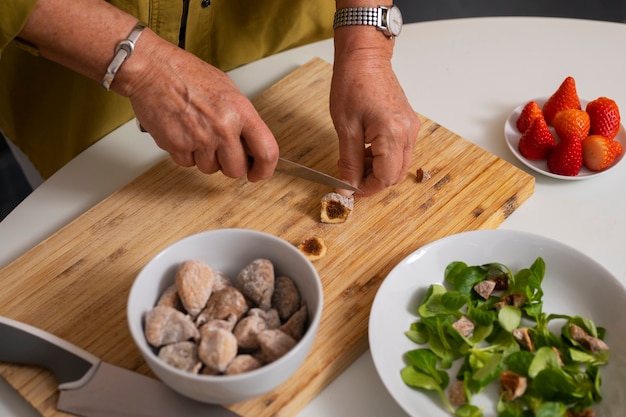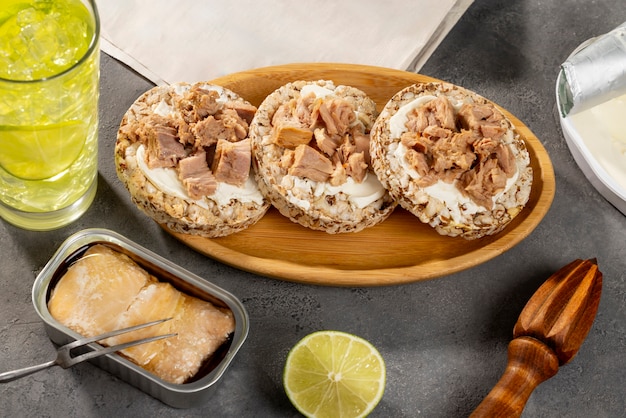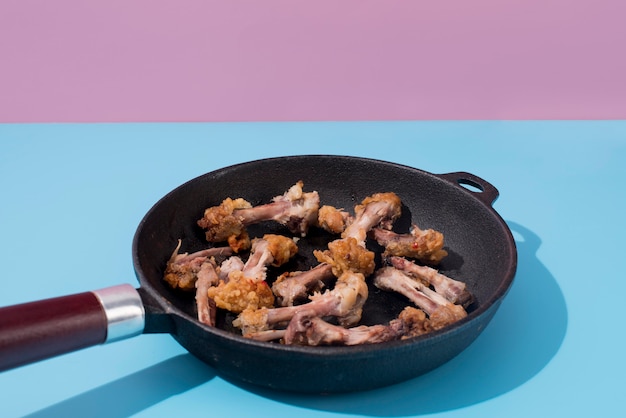Let's talk carnitas, my friends. You know, those melt-in-your-mouth, succulent, flavour-packed pork shoulder beauties that have you dreaming of sunny Mexican streets and vibrant markets? For years, I'd been eyeballing those carnitas on the menu at my favourite Mexican restaurant, thinking, "I could totally make that myself." And you know what? I did. And it was bloody brilliant. So, if you're ready to ditch the takeaway and embrace the glorious world of home-cooked carnitas, you've come to the right place. This guide is your roadmap to carnitas perfection, packed with tips, tricks, and my own personal experiences (and a few blunders along the way, let's be honest). Let's get started, shall we?
(Part 1) Setting the Scene: The Carnitas Journey Begins

Choosing Your Weapon: The Pork Shoulder
First things first, you need the right pork. Now, I'm talking about a hefty pork shoulder, my friend. Think 3-4 pounds, bone-in or boneless, it’s up to you. I personally prefer bone-in – it adds a lovely depth of flavour and keeps things juicy. Plus, there's something satisfying about gnawing on a little bit of bone at the end of your carnitas feast! But if you’re going for a more convenient option, boneless will do the trick. Just make sure it’s a good cut, with a nice layer of fat. Trust me, that fat is your friend. It’s what makes the meat so incredibly tender and flavourful, rendering down into luscious, golden goodness as it cooks.
The Spice Rack: Building the Flavour Profile
Now, onto the seasoning. This is where you get to really personalize your carnitas. The classic Mexican flavours are what I go for, but don’t be afraid to experiment! You’ll need a blend of spices like cumin, chili powder, oregano, and garlic powder. These are the backbone of carnitas, the foundation for a truly authentic flavour. You can find pre-made carnitas seasoning blends, but I prefer to make my own. There's something about creating that perfect blend of spices that really gets me going. It's like a little culinary adventure, you know? I'll add in a pinch of smoked paprika for a smoky depth, a touch of cayenne pepper for a bit of heat (optional, of course, depending on your spice tolerance), and a sprinkle of salt and pepper to round out the flavour.
The Marinating Game: Time for a Little Pampering
Alright, the pork is ready, the spices are waiting, now it's time for the magic to happen - marinating! I like to let my pork sit in a marinade for at least a few hours, or even overnight. It really helps to infuse the meat with flavour, making it incredibly juicy and tender. I use a simple marinade with lime juice, orange juice, a bit of olive oil, and a splash of white vinegar. The citrus juices tenderise the meat, while the olive oil adds richness and the white vinegar provides a bit of tang. But honestly, you can get creative with this. Try a bit of soy sauce for a savory depth, or some chopped onions and garlic for extra oomph. It's all up to you! The beauty of cooking is that you can always put your own personal touch on things.
(Part 2) The Cooking Process: Bringing the Carnitas to Life

The Low and Slow Method: Patience is Key
Now, the moment of truth - cooking the carnitas. You can do this in a few ways: in the oven, on the stovetop, or even in a slow cooker. But my personal favourite method is low and slow cooking in the oven. It’s simple, hands-off, and produces incredibly tender, juicy carnitas. Pre-heat your oven to 300 degrees Fahrenheit (150 degrees Celsius). Place the seasoned pork shoulder in a roasting pan, and add some of that marinade around it. Cover the pan tightly with foil and let it cook for about 4-5 hours. The meat should be incredibly tender and falling apart easily. The aroma that fills your kitchen during this time is absolutely intoxicating.
The Shredding Ritual: A Feast for the Senses
After the long, slow cook, you’ve got a beautiful, juicy pork shoulder. But we’re not quite done yet! The next step is shredding. Grab two forks and gently pull the meat apart, shredding it into juicy, succulent pieces. It's so satisfying to see all those strands of meat unraveling, releasing that incredible aroma. You can use two forks, or even your hands (I usually go for a mix of both). Don’t worry about being too neat, you want those beautiful, rustic strands of carnitas. This is where your patience really pays off. The longer you cook the pork, the easier it will be to shred.
The Crispy Finish: The Secret Weapon
Okay, so you’ve got your shredded carnitas, but hold on, we’re not quite there yet. The final touch - crisping up those delicious little strands. It adds a wonderful texture contrast, and takes the flavour to another level. You can crisp the carnitas in a skillet on the stovetop, or in the oven. I personally prefer the stovetop method. Heat some oil in a cast-iron skillet over medium-high heat. Add the shredded carnitas and cook until crispy, stirring occasionally. This takes about 5-10 minutes, depending on how crispy you like it. Be careful not to overcook, you want a nice golden brown colour and a satisfying crunch. The aroma of the crisping carnitas is a siren call, trust me, you won't be able to resist!
(Part 3) The Garnishing Game: Adding a Touch of Magic

The Salsa Spectrum: A Symphony of Flavours
Carnitas are a blank canvas. You can add anything you want, and it will be amazing. But for me, the key is the salsa. Salsa adds a burst of freshness, tang, and complexity to your carnitas. My personal favourite is a vibrant pico de gallo, with juicy tomatoes, chopped onions, cilantro, and a squeeze of lime juice. It's a classic combination that really brings out the best in carnitas. But you can go for a chunky salsa verde, a smoky roasted salsa, or even a fiery habanero salsa. It's all about your taste preferences. Experiment and find your perfect salsa match!
The Creamy Touch: Avocado Bliss
Okay, I’m going to be honest, I’m a sucker for avocado. It’s smooth, creamy, and brings a wonderful richness to the carnitas. Slice or dice some avocado and sprinkle it over your carnitas. It's a classic combination for a reason. You can also add a dollop of sour cream or crema fresca for an extra layer of creaminess. These creamy additions complement the richness of the carnitas beautifully.
The Toppings Extravaganza: Unleash Your Creativity
Want to go beyond the basics? Feel free to explore! Add some fresh cilantro for an extra burst of freshness. Sprinkle some crumbled queso fresco for a salty, tangy kick. Or add some chopped red onion for a bit of bite. The possibilities are endless! And if you're feeling adventurous, try adding some grilled pineapple for a touch of sweetness or some pickled onions for a tangy crunch. Your imagination is the limit!
(Part 4) The Serving Ceremony: Putting Your Carnitas to the Test
Taco Time: The Ultimate Carnitas Experience
Carnitas are the perfect filling for tacos. Warm up some corn tortillas (I prefer them slightly charred, for a smoky flavour). Fill them with your juicy carnitas, top with your favourite salsas, and get ready for a taste explosion. You can also add some shredded lettuce, diced tomatoes, or a drizzle of hot sauce for extra flavour. The best part about tacos is that you can make them exactly how you like them. No judgment here!
Beyond the Taco: Expanding the Carnitas Horizon
While tacos are an absolute classic, there's a whole world of possibilities beyond that. Try adding your carnitas to burritos, quesadillas, or even salads. I’ve even been known to use them as a topping for nachos. It's all about getting creative and finding new ways to enjoy those delicious carnitas. Remember, carnitas are incredibly versatile. You can use them in almost any Mexican dish, or even create your own unique creations. The possibilities are endless!
(Part 5) The Leftover Magic: Turning Scraps into Treasures
Let’s face it, you’re probably going to have some leftover carnitas (unless you’ve got a huge appetite). But don’t worry, these leftovers are a treasure! You can reheat them in the oven or microwave, then use them for a quick and easy lunch or dinner. My go-to leftover carnitas recipe is a simple carnitas salad. Toss the shredded carnitas with some mixed greens, chopped tomatoes, and a light vinaigrette. It’s a delicious and healthy way to use up those leftover gems. And let's be honest, those leftover carnitas are even better the next day! The flavours meld together, creating an even more delicious experience.
(Part 6) The Carnitas Journey: My Personal Adventures
The First Attempt: A Culinary Triumph
I’ll never forget my first time making carnitas at home. I was so nervous, thinking "what if it doesn’t turn out right?" But when I pulled that pork shoulder out of the oven, and the meat just fell apart, I was ecstatic. The aroma was incredible, and the flavour was out of this world. I devoured a couple of tacos that night, and I’m not ashamed to admit that I had seconds. It was a moment of pure culinary bliss.
The Epic Fail: Learning from Mistakes
Of course, not every attempt is a success. I once tried making carnitas in my slow cooker. I thought it would be a great way to let the meat cook all day long. But it turned out to be a bit of a disaster. The meat ended up a bit dry, and I had to salvage the situation by adding some extra broth and cooking it a bit longer. Lesson learned: sometimes the oven is the way to go. You live and you learn, right? It's all part of the culinary adventure.
The Ultimate Triumph: Mastering the Art
Over the years, I've perfected my carnitas recipe. I've experimented with different seasonings, tried different cooking methods, and learned from my mistakes. Now, I can make carnitas with my eyes closed. I’ve got the timing down pat, the seasoning is perfect, and the results are consistently delicious. It’s become one of my signature dishes, and I love sharing it with friends and family. The joy of cooking is in the journey, the constant experimentation, and the satisfaction of creating something delicious.
(Part 7) The Secrets to Carnitas Success: Tips and Tricks
The Don't-Forget-It List: Essential Carnitas Supplies
- Heavy-duty roasting pan or dutch oven: This will ensure your pork shoulder has plenty of room to cook and release all that delicious fat.
- meat thermometer: This is a must-have for any serious cook, but especially for carnitas. It helps you ensure that the meat is cooked to perfection.
- Two forks (for shredding): These are your trusty tools for transforming that cooked pork shoulder into tender, juicy strands.
- Cast-iron skillet (for crisping): A cast-iron skillet is the best tool for crisping up your carnitas. It distributes heat evenly and creates a beautiful, golden brown crust.
- Corn tortillas: These are the classic vehicle for carnitas. Warm them up slightly before filling them with your delicious carnitas.
- Your favourite salsas and toppings: Don't forget the toppings! They add a burst of flavour and texture to your carnitas.
The Timing Game: Mastering the Cooking Process
One of the most important aspects of making carnitas is timing. You need to make sure the pork cooks for long enough to become incredibly tender, but not so long that it dries out. I usually cook it for 4-5 hours at 300 degrees Fahrenheit. But every oven is different, so you might need to adjust the cooking time slightly. Use a meat thermometer to check the internal temperature. The pork should reach an internal temperature of 190 degrees Fahrenheit (88 degrees Celsius) for the best results. Remember, patience is key when it comes to carnitas.
The Shredding Technique: Achieving That Perfect Texture
You’ve got your tender, cooked pork, now it’s time for shredding! This is where some people struggle, but it’s actually quite simple. Use two forks and gently pull the meat apart, shredding it into juicy, succulent pieces. Don't worry about being too neat, you want those beautiful, rustic strands of carnitas. If you find that the meat is still a bit tough, you can give it a little bit more time in the oven to soften up. The key is to be gentle and work with the grain of the meat.
The Crisping Dilemma: Finding the Right Crunch
You’ve got your shredded carnitas, now it’s time for the final step – crisping them up! This is where the magic happens. You want a nice golden brown colour and a satisfying crunch. I personally prefer to crisp them up in a cast-iron skillet over medium-high heat, but you can also use your oven. Just make sure to add a little bit of oil to the skillet or baking sheet, and cook the carnitas until they are crispy and golden brown. Be careful not to overcook, you don't want the carnitas to become dry.
The Flavor Boost: Adding That Extra Oomph
Carnitas are delicious on their own, but you can always add a little extra oomph to the flavour. I like to add a bit of lime juice and chopped cilantro to my carnitas before crisping them up. This adds a burst of freshness and acidity. You can also add some chopped onions, or even a bit of garlic. It's all about your taste preferences!
(Part 8) The Carnitas Experience: Sharing the Love
I love sharing my carnitas with friends and family. It's always a hit, and everyone raves about how delicious and tender the meat is. And it’s a great dish to share, as you can assemble tacos, burritos, or quesadillas together. It's a fun and interactive way to enjoy a meal, and it always leads to lots of laughter and good times.
The Legacy of Carnitas: Passing on the Passion
One of the best things about cooking is sharing your passion with others. I love teaching friends and family how to make my carnitas. It’s a great way to bond over food, and it’s so rewarding to see someone else enjoy your creation. I’ve even had friends tell me that they’ve made my carnitas recipe for their own families, and it’s become a family tradition. That’s what makes cooking so special, the ability to share your love of food with others and create memories that last a lifetime.
FAQs
1. What is the best cut of pork for carnitas?
The best cut of pork for carnitas is the shoulder. It’s a fatty cut of meat that cooks down incredibly tender and juicy. You can use bone-in or boneless shoulder, but I prefer bone-in because it adds a lovely depth of flavour. The bone also helps to keep the meat moist during cooking.
2. How long should I cook carnitas?
The cooking time for carnitas will vary depending on the size of your pork shoulder and the cooking method you are using. I recommend cooking it for 4-5 hours at 300 degrees Fahrenheit (150 degrees Celsius) in the oven. You can also cook it in a slow cooker on low for 6-8 hours. Use a meat thermometer to check the internal temperature of the pork. It should reach an internal temperature of 190 degrees Fahrenheit (88 degrees Celsius). Remember, the longer you cook the pork, the more tender it will become.
3. What are the best toppings for carnitas?
The best toppings for carnitas are really up to you. I love to add a vibrant pico de gallo, sliced avocado, and a dollop of sour cream or crema fresca. These classic toppings add a burst of freshness, creaminess, and tang. You can also add fresh cilantro, crumbled queso fresco, chopped red onion, or even some grilled pineapple. Get creative and experiment with different toppings until you find your perfect combination.
4. What can I do with leftover carnitas?
Leftover carnitas are a treasure! You can reheat them in the oven or microwave, then use them for a quick and easy lunch or dinner. They're great in tacos, burritos, quesadillas, or even salads. I also love to make a simple carnitas salad with leftover carnitas, mixed greens, chopped tomatoes, and a light vinaigrette. Don't be afraid to get creative with your leftovers.
5. Can I make carnitas in the instant pot?
Yes, you can absolutely make carnitas in the Instant Pot! It’s a great way to get tender, juicy carnitas in a shorter amount of time. Just sear the pork shoulder in the Instant Pot, then add your seasonings and cook on high pressure for 60-75 minutes. Allow the pressure to release naturally for 10 minutes, then shred the meat and enjoy! The Instant Pot is a great tool for making carnitas, especially if you're short on time.
Everyone is watching

Corn on the Cob: The Ultimate Guide to Perfectly Cooked Ears
Healthy MealsAh, corn on the cob. Just the name evokes images of sunny days, barbecues, and that sweet, juicy flavour that ...

Perfect Pork Roast Oven Cooking Time: A Guide to Delicious Results
Healthy MealsThere's something truly satisfying about a perfectly roasted pork. The aroma alone is enough to make your mout...

Ham Cooking Time: How Long to Bake, Smoke, or Boil a Delicious Ham
Healthy MealsAh, ham. It's a classic, isn't it? A real crowd-pleaser, especially around holidays. And when done right, it'...

Scallops: The Ultimate Guide to Perfect Cooking
Healthy MealsAh, scallops. Those delicate, sweet, and utterly delicious morsels of the sea. They hold a special place in my...

Spaghetti Squash: The Ultimate Guide to Cooking and Serving
Healthy MealsRemember that time you saw spaghetti squash at the supermarket, looking all bumpy and strange, and thought, "W...
